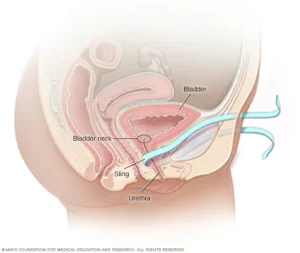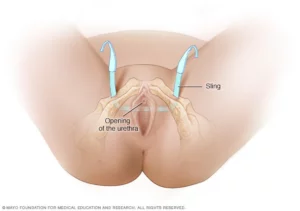What Is a Urethral Sling?
A urethral sling is a treatment for stress urinary incontinence (SUI)—the unintentional leakage of urine during activities like coughing, laughing, sneezing, or exercise. The sling is a small strip of synthetic mesh or natural tissue placed under the urethra to support it and prevent leakage.
Who Might Benefit from a Sling?
-
Women with moderate to severe stress incontinence
-
Individuals who have not improved with pelvic floor therapy or medications
-
Some men, especially after prostate surgery, may also be candidates for a male sling
How Does It Work?
The sling acts like a hammock under the urethra. When you cough, sneeze, or move, the sling provides extra support to keep the urethra closed and prevent leaks.
Types of Slings
-
Mid-urethral sling: Most common; placed through a small vaginal incision
-
Retropubic or transobturator approaches: Different paths used to place the sling depending on anatomy and surgeon preference
-
Autologous sling: Made from your own tissue
-
Male sling: Placed differently but serves the same purpose in men
The Procedure: What to Expect
-
Typically outpatient (go home the same day)
-
Takes about 30–60 minutes
-
Performed under general or spinal anesthesia
-
Small incisions in the vaginal wall (for women) or perineal area (for men)
-
Most slings are made from safe, synthetic mesh material
Recovery
-
Most patients return to normal activities in 1–2 weeks
-
Avoid heavy lifting, straining, or sexual activity for 4–6 weeks
-
You may have a catheter temporarily after surgery
-
Follow-up visit is usually within 1–2 weeks
Benefits
-
Long-term success rate is 75–90%
-
Minimally invasive with small incisions
-
Can significantly reduce or eliminate leakage
Risks and Side Effects
As with any surgery, there are some potential risks:
-
Temporary trouble urinating
-
Urinary tract infections (UTIs)
-
Mesh-related complications (exposure or erosion) – rare
-
Pain or discomfort
-
Overactive bladder symptoms (urgency or frequency)
Most complications are treatable if caught early—be sure to attend follow-up appointments.
FAQs
Will I be completely dry after surgery?
Many patients experience major improvement or complete dryness, but results vary.
Is the mesh safe?
Yes. The sling mesh used today is different from older types used in pelvic organ prolapse repairs. It is smaller, well-studied, and considered safe when placed properly by an experienced surgeon.
Will I need more treatments later?
Most slings last many years, but in some cases, symptoms can return and may require additional treatment.
Can I still do pelvic floor exercises?
Yes—and it’s encouraged! Strengthening pelvic floor muscles can support long-term success.
When to Call the Doctor
-
Trouble urinating after surgery
-
Fever or signs of infection
-
Severe pain or heavy bleeding
-
Leaking that worsens or doesn’t improve over time
Final Notes
Urethral sling surgery is a well-established and effective option for treating stress incontinence. Be sure to discuss your goals, lifestyle, and preferences with your healthcare provider to decide if it’s right for you.


